Termite Damage in Your Crawl Space: 7 Ways to Stop It
Crawl spaces are often overlooked, but when it comes to termites, this area should be a priority. Termites silently undermine the structural integrity of your home, leading to significant damage and costly repairs. Learn to identify the signs of termite damage in a crawl space and the seven preventative measures you can take to ensure the long-term protection, safety, and health of your home.
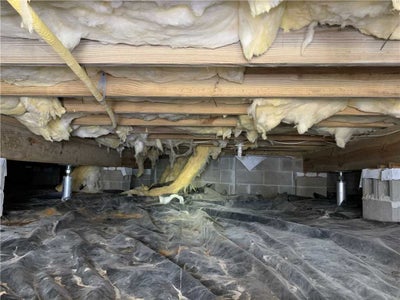
Are Termites Common in a Crawl Space?
Termite infestations are common in crawl spaces due to the damp, dark environment these areas provide. Pests thrive in poorly ventilated crawl spaces that contain wooden support beams and floor joists, high humidity levels, and direct contact to soil. Crawl spaces are the ideal environment for termites, since they feed on organic materials like wood-based items, cellulose in insulation, cardboard, drywall, and natural fiber materials.
How Do You Know if You Have Termite Damage?
Identifying termite damage is crucial for maintaining a safe and healthy home environment. Here are the common signs to look for:
- Sagging Floors or Ceilings: Termite damage weakens structural supports, causing sagging floors, ceilings, and damage to walls.
- Mud Tubes: Termites build mud tubes as pathways between their nest and food source. These pencil-sized tubes are found in foundation walls, crawl spaces, and other places in your home.
- Swarmers: Termite swarmers are reproductive termites that abandon their colonies during the spring to start new ones. These pests shed their wings during this time, signaling an active infestation.
- Damaged Wood: Hollowed or damaged wood in crawl spaces, basements, around plumbing, or other high moisture areas may indicate termite infestation.
- Tight-Fitting Doors and Windows: Termite damage can cause windows and doors to become difficult to open and close due to structural weakening.
There are many signs of termite damage. Professional inspections ensure the most suitable repairs for your property.
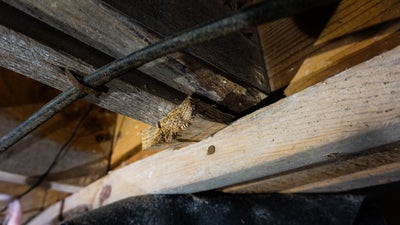
7 Ways to Stop Termite Damage
Identifying and treating termite damage early saves your home from costly repairs. Here are seven methods to stop and prevent termite damage in a crawl space:
1. Crawl Space Encapsulation
Encapsulation creates a barrier around the area, stopping pests and termite damage in crawl spaces. This method reduces the risk of termites and other pests and eliminates the moisture that causes mold, mildew, wood rot, and structural damage. Crawl space encapsulation improves overall crawl space health with vapor barriers, sump pumps, drainage systems, insulation, and dehumidifiers.
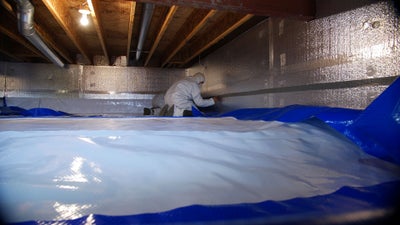
2. Minimize Wood Debris
Remove scrap wood, lumber piles, and nearby firewood to eliminate the food source providing nutrients for termites.
3. Use Treated Wood and Soil
Termites travel between soil and wood, so maintaining a gap between the crawl space floor joists and the foundation walls reduces the pathway of travel. Use pressure-treated lumber for wood supports touching the soil and treated soil to discourage termite migration. Choose non-organic mulch materials like rubber or gravel, which are less attractive to termites.
4. Seal Concrete Cracks and Gaps
Seal concrete cracks and gaps in the foundation to prevent termite entry into the crawl space. A well-sealed foundation creates a barrier against termite infestations.
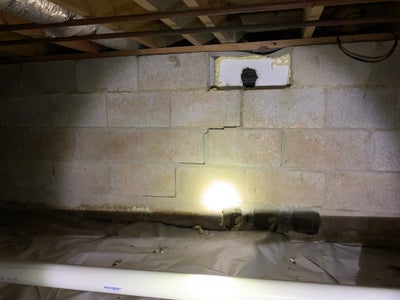
5. Install Foundation Termite Shield
Metal or plastic termite shields and barriers placed between the foundation and soil create obstacles for termites, preventing them from accessing their pathways into the crawl space.
6. Regular Inspections
Annual crawl space inspections by professional helps identify early signs of termite activity and prevent costly associated damage.
7. Contact a Crawl Space Professional
If you suspect your home has pests or termite damage in the crawl space, contact a professional for an inspection. An expert will identify, diagnose, and implement a treatment plan to protect your home’s health and crawl space.
Preventative encapsulation measures reduce the risk of moisture and termite infestation, offering homeowners peace of mind. Contact a crawl space professional to ensure your home remains in optimal condition for long-term protection.
Contact Bay Area Underpinning for a Free Inspection
Protecting your home from termite damage is essential to its structural integrity and well-being. Bay Area Underpinning offers tailored crawl space encapsulation methods to minimize the moisture that attracts pests and causes damage. Our patented repair solutions provide superior protection against termite damage in crawl spaces. Contact us today for a free inspection and to learn more about how crawl space encapsulation enhances home health and indoor air quality.
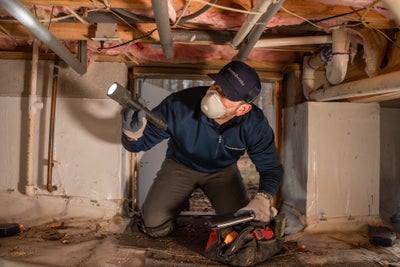
Publish Date:
Last Modified Date:

Our Locations
2333 Courage Dr. Suite C
Fairfield, CA 94533
1161 N Fair Oaks Ave
Sunnyvale, CA 94089
